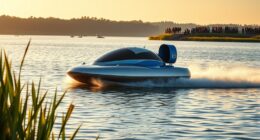To improve deep-water starts as a heavy rider, guarantee you select a snug, durable wetsuit and sturdy fins for stability. Always perform safety checks on your gear and practice in shallow water first. Focus on maintaining proper body position and controlled breathing to boost confidence and conserve energy. Using well-fitted, buoyant equipment helps reduce stress and improve safety. Continue exploring these hacks to master deep-water starts with greater ease and confidence.
Key Takeaways
- Use a well-fitted, high-quality wetsuit to enhance buoyancy and reduce drag during the start.
- Select sturdy fins and a comfortable snorkel/mask to improve propulsion and breathing efficiency.
- Practice shallow water entries to build confidence and refine technique before deep-water starts.
- Incorporate controlled breathing and safety checks to prevent panic and ensure gear reliability.
- Have a buddy or spotter nearby for assistance and safety reassurance during the start.

Starting a deep-water sprint can be intimidating, but with the right hacks, you can jump in confidently and conserve energy. One of the first things you should focus on is equipment selection. Heavy riders need gear that offers stability, comfort, and security. Choose a wetsuit that fits snugly but doesn’t restrict your movement. A well-fitting wetsuit helps reduce drag and keeps you buoyant, making it easier to maintain proper body position. Make sure your fins are sturdy and comfortable, providing enough propulsion without causing fatigue. If you’re using a buoyancy aid or a life vest, pick one designed specifically for heavy users—these tend to have extra support and help keep you afloat in the right posture. Also, invest in a high-quality, durable snorkel and mask to improve breathing efficiency and visibility underwater. Good equipment not only boosts confidence but also minimizes the risk of equipment failure during your start, which can be dangerous. Additionally, practicing proper body positioning and breathing techniques can significantly enhance your start efficiency and safety.
Safety precautions are paramount when performing deep-water starts, especially for heavy riders. Before jumping in, ensure you’re familiar with the water conditions. Check for strong currents, waves, or other hazards that could make your start tricky or unsafe. Always perform a quick safety check of your gear—make sure your wetsuit zips are secure, your fins aren’t damaged, and your snorkel and mask fit properly. It’s wise to have a buddy or a spotter nearby who can assist if needed. Practice your entry and start in shallow water first, so you build confidence and refine your technique without the added pressure of deep water. Remember, never rush into a deep-water start without understanding your limits. Know how to regain your buoyancy if you tire or feel overwhelmed. Also, be aware of your breathing pattern and keep steady, controlled breaths to avoid panic. Staying calm is essential; panic wastes energy and can compromise your safety.
Finally, always listen to your body and respect your pace. Proper equipment and safety precautions aren’t just about avoiding injuries—they help you perform better and enjoy the experience more. Staying prepared allows you to focus on technique and energy conservation, making your deep-water start more efficient and less stressful. By combining the right gear with vigilant safety practices, you set yourself up for a confident and successful deep-water sprint, no matter your size or skill level. Remember, mastering Proper equipment and safety measures can make all the difference in your deep-water performance.
Frequently Asked Questions
What Are the Safest Deep-Water Start Techniques for Beginners?
When learning deep-water starts, safety is key. You should focus on equipment safety by ensuring your wetsuit and gear fit properly. Follow beginner tips like practicing breath control and using a flotation device if needed. Keep your movements smooth and confident, and always stay aware of your surroundings. With patience and proper technique, you’ll build confidence and improve your deep-water start skills safely and effectively.
How Can I Improve My Balance During Deep-Water Starts?
To improve your balance during deep-water starts, focus on strengthening your core stability, which provides a solid foundation and helps you stay steady. Additionally, work on ankle flexibility to enhance your control and maneuverability in the water. Practice controlled breathing and maintain a relaxed posture to stay calm. With consistent effort, you’ll find it easier to keep your balance, making your deep-water starts more confident and efficient.
What Equipment Aids Can Assist With Heavy Rider Deep-Water Starts?
To assist with heavy rider deep-water starts, consider using goggles accessories to improve visibility and comfort. Buoyancy aids are also essential, providing extra support and helping you stay afloat more easily. These equipment aids can boost your confidence and stability during the start, making it easier to maintain balance and momentum. Incorporate these tools into your practice to enhance your overall deep-water start technique and safety.
How Do Wind and Currents Affect Deep-Water Start Success?
Wind and currents considerably impact your deep-water start success. Strong winds can create choppy conditions, making it harder to maintain balance and momentum. Currents can either aid or hinder your progress, depending on their direction. To prepare, use marine navigation tools and weather forecasting updates to plan your session. By understanding these factors, you can choose ideal timing and conditions, increasing your chances of a smooth, successful start.
Are There Specific Training Routines to Master Deep-Water Starts Quickly?
Think of mastering deep-water starts as planting a sturdy seed. You’ll want to focus on a targeted training routine that acts like sunlight and water—specifically, dive simulations to build your comfort with water entry and strength conditioning to power your pushes. Consistent practice accelerates growth, helping you develop confidence and speed. With dedication, you’ll harvest smooth, powerful starts, transforming initial struggles into effortless dives.
Conclusion
Now that you know these deep-water start hacks, you’re ready to conquer the waves with confidence, ease, and style. Embrace the technique, trust your skills, and stay persistent. Practice consistently, stay patient, and keep pushing your limits. With each attempt, you’ll improve, grow stronger, and enjoy every ride more. Remember, success comes from effort, effort comes from belief, and belief comes from trying. So get out there, stay motivated, and make every wave your own.










